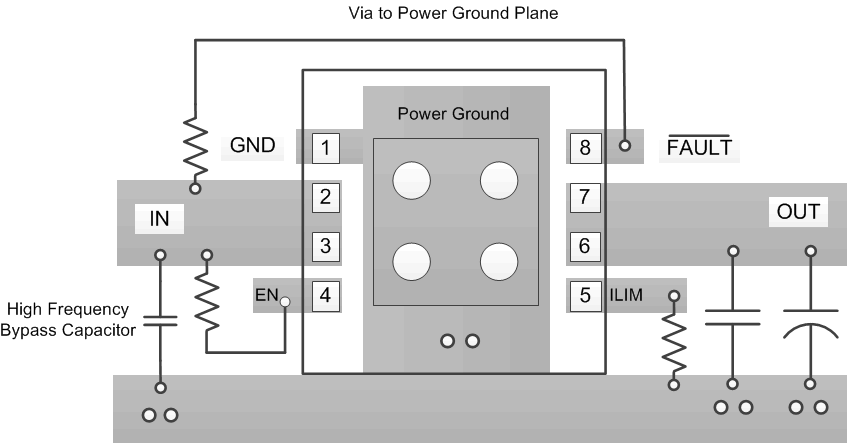SLVS931B November 2009 – December 2016 TPS2556 , TPS2557
PRODUCTION DATA.
- 1 Features
- 2 Applications
- 3 Description
- 4 Revision History
- 5 Device Comparison Table
- 6 Pin Configuration and Functions
- 7 Specifications
- 8 Parameter Measurement Information
- 9 Detailed Description
-
10Application and Implementation
- 10.1 Application Information
- 10.2
Typical Applications
- 10.2.1 Current-Limiting Power-Distribution Switch
- 11Power Supply Recommendations
- 12Layout
- 13Device and Documentation Support
- 14Mechanical, Packaging, and Orderable Information
Package Options
Mechanical Data (Package|Pins)
- DRB|8
Thermal pad, mechanical data (Package|Pins)
- DRB|8
Orderable Information
12 Layout
12.1 Layout Guidelines
- TI recommends placing the 100-nF bypass capacitor near the IN and GND pins, and make the connections using a low-inductance trace.
- TI recommends placing a high-value electrolytic capacitor and a 100-nF bypass capacitor on the output pin when large transient currents are expected on the output.
- The traces routing the RILIM resistor to the device must be as short as possible to reduce parasitic effects on the current limit accuracy.
- The PowerPAD must be directly connected to PCB ground plane using wide and short copper trace.
12.2 Layout Example
 Figure 25. TPS255x Layout Example
Figure 25. TPS255x Layout Example
12.3 Thermal Considerations
The low on-resistance of the N-channel MOSFET allows small surface-mount packages to pass large currents. It is good design practice to estimate power dissipation and junction temperature. This analysis gives an approximation for calculating junction temperature based on the power dissipation in the package. However, thermal analysis is strongly dependent on additional system level factors. Such factors include air flow, board layout, copper thickness and surface area, and proximity to other devices dissipating power. Good thermal design practice must include all system level factors in addition to individual component analysis.
Begin by determining the rDS(ON) of the N-channel MOSFET relative to the input voltage and operating temperature. As an initial estimate, use the highest operating ambient temperature of interest and read rDS(ON) from the typical characteristics graph. Using this value, the power dissipation can be calculated by Equation 8.
where
- PD = Total power dissipation (W)
- rDS(ON) = Power switch on-resistance (Ω)
- IOUT = Maximum current-limit threshold (A)
Finally, calculate the junction temperature with Equation 9.
where
- TA = Ambient temperature (°C)
- RθJA = Thermal resistance (°C/W)
- PD = Total power dissipation (W)
Compare the calculated junction temperature with the initial estimate. If they are not within a few degrees, repeat the calculation using the refined rDS(ON) from the previous calculation as the new estimate. Two or three iterations are generally sufficient to achieve the desired result. The final junction temperature is highly dependent on thermal resistance, and thermal resistance is highly dependent on the individual package and board layout.